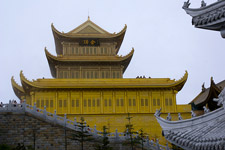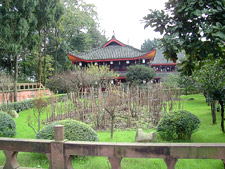Mount Emei rises in the southwestern part of the Chengdu Plain in Emeishan City, Sichuan Province. There are four scenic regions within the area: Baoguo Temple, Wannian Temple, Qingyin Pavilion and Golden Summit. Its main peak, the Golden Summit, is 3079.3 meters (10,103 feet) above the sea level. In 1996 Mount Emei was enlisted in the world natural and cultural heritage by the UNESCO.

History
Mount Emei is one of the four celebrated Buddhist Mountains in China. It is said that Buddhism was brought to Mount Emei in the first century BC. After nearly 2,000 years of development, it has become a place rich in Buddhist heritage, which has made it an influential sacred place in China and even in the whole world.
Mount Emei is called the “mountain of brightness” in Buddhism. The legend goes that the Guangxiang Temple on the mountain top was where the goddess of benevolence performed Buddhist rituals, thus making it one of the four famous sacred mountains of Buddhism in China.
What to see
The trees here are verdant almost all the year round. Visitors are enamoured by splendid waterfalls, quiet sceneries and a landscape that varies according to the seasons, the height of mountain and the climate.
The craggy southern part of the mountain is crisscrossed by ravines and covered with a dense growth of plants, while the northern part features sheer precipices, and waterfalls cascading down the slope.
There used to be over 100 temples and halls on the mountain, but only some 20 still stand.
Baoguo Temple
The Baoguo Temple situated at the foot of the mountain is the largest temple on Mount Emei, built during the Ming Dynasty (1368-1644). The climate here is mild and trees are verdant and serried. Visitors to this temple can enjoy either the renowned ancient buildings and precious Buddhist cultural relics or peculiar natural attractions and rare animals and plants.
 Facing the east, Baoguo Temple awaits the arrival of the rising sun in the morning and sends off the setting sun in the dusk. In front of the temple gate there is a pair of stone lions carved in the Ming Dynasty (1368-1644). They are lively, grand and mighty, like door guards protecting the temple as well as the Mount Emei. A large engraved stone slab hangs above the gate with the name of the temple on it which was written by the Emperor Kangxi (1654-1722) of the Qing Dynasty (1644-1911).
Facing the east, Baoguo Temple awaits the arrival of the rising sun in the morning and sends off the setting sun in the dusk. In front of the temple gate there is a pair of stone lions carved in the Ming Dynasty (1368-1644). They are lively, grand and mighty, like door guards protecting the temple as well as the Mount Emei. A large engraved stone slab hangs above the gate with the name of the temple on it which was written by the Emperor Kangxi (1654-1722) of the Qing Dynasty (1644-1911).
Qingyin Pavilion
Qingyin Pavilion sits right in the middle of Mount Emei. It is no exaggeration to say that the whole area of the pavilion is a fine picture with green hills and blue water.
At its highest point there are towering exquisite and refined pavilions. Two gloriettes stand in the middle of the region of Qingyin Pavilion. There is one stone bridge crossing on the Black Dragon River (The color of the water is dark green.) and the White Dragon River (The color of the water is ivory.) on each side of the gloriette. The two bridges are like a pair of wings, so a beautiful name was given to them: Double Flying Bridges. In the lower point, you can see the Black Dragon River on the right of the Cattle Heart Pavilion and White Dragon River on its left.
The billowing waves strike the huge stone in the green pond giving out the roaring sound time and again and echoing around the surrounding valleys and woods. The water splashing in all directions like broken pieces of crystal pearls and jade and forms a series of water drops flying in the air and then drop into the pond.
In the night with full moon and soft wind, all is quiet and there is only the melodious sound of water resounding in the air. Listening to the clear sound, it is easy to be lulled into a state of quietude, allowing oneself to be totally immersed with the natural surrounding.
Wannian Monastery
The scenery in Wannian Monastery is pleasant all the year around but especially in autumn. In autumn there is heat of summer at the foot of the Mount Emei even though snow has fallen on the top, but it is the best season to visit the Wannian Temple.
 Here red leaves are reflected in the water and when a breeze comes the leaves dance in the pond forming red waves glistening in the sunlight. So thrilling! Also in the Wannian Temple scenic region, there are mountain villages creating a peaceful and intoxicating picture.
Here red leaves are reflected in the water and when a breeze comes the leaves dance in the pond forming red waves glistening in the sunlight. So thrilling! Also in the Wannian Temple scenic region, there are mountain villages creating a peaceful and intoxicating picture.
Looking around beside the White Water Pond, the wind touches the mountains, wobbling the trees making a howling sound; red leaves have a dance to the wind in the air; the ripply stream water goes rightly through the temple and is crooning and echoing the wind.
Golden Summit
The Golden Summit gets its name from a bronze house which was there. The weather here is cold in all year round but its natural scenery is wonderful. The four great spectacles of Golden Summit and also of Mount Emei are sunrise, clouds sea, Buddha rays and saint lamps. They are the essence of the beauty and mysterious charm of Mount Emei.
 Due to the different weather conditions and seasons, the sunrise at the Golden Summit is varied. On a fine day, visitors can enjoy the whole process of the sunrise. If there is cloudy haze in the east sky, it is already a red sun far above the horizon when you see the sunrise; if the sky is covered with cloud, it is suffused with sun glow and awashed with sea of clouds.
Due to the different weather conditions and seasons, the sunrise at the Golden Summit is varied. On a fine day, visitors can enjoy the whole process of the sunrise. If there is cloudy haze in the east sky, it is already a red sun far above the horizon when you see the sunrise; if the sky is covered with cloud, it is suffused with sun glow and awashed with sea of clouds.
Mount Emei and the Leshan Giant Buddha have now been unified into one scenic area and were put on the world cultural and natural heritage lists in 1996.



